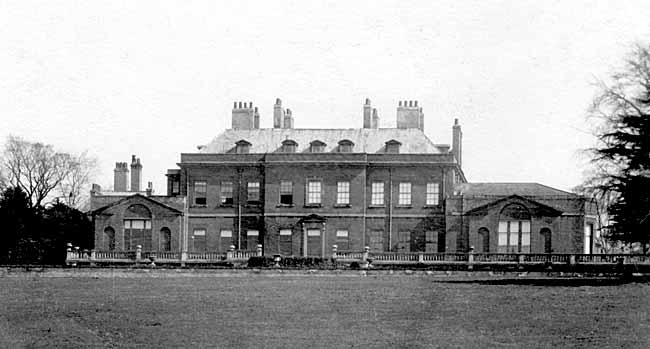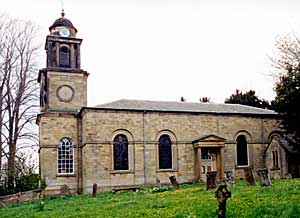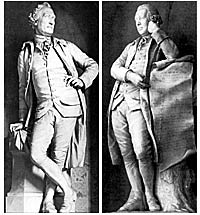< Previous | Contents | Next >
The Ship of Good Fortune

Ossington Hall in the 1920s.
OSSINGTON. The world seems far away in this delightful spot at the end of a charming ride from Kneesall. Its lanes are leafy glades; its few dwellings are trim with red walls and roofs. Not far from a group of stately larches, sheltering a bronze crucifix to men who died for peace, a fine lime avenue leads to the church and the gates of Ossington Hall.
From the road to Moorhouse we have a splendid view of the modern hall in its park, beyond a sheet of water formed by a stream flowing to the Trent. The house stands where stood an older dwelling destroyed in the Civil War. It was the home of the Cartwrights, who in 1780 sold the manor to William Denison, a wealthy wool merchant who rebuilt the church, setting it so close to the hall that we have a peep of its grounds from the churchyard.

Ossington church in 2003.
Built in classical style, with a domed tower to which a Speaker of the House of Commons gave a clock, the church has rich glass filling its round-headed windows, and is interesting for monuments of Cartwrights and Denisons. Older than any of these are two brass portraits on a great tomb, one showing Reynold Peckham of Wrotham in Kent (who died in 1551) as a knight in armour, and the other his wife in a long gown and embroidered headdress. On a huge stone monument of 1602, adorned with arms, are William Cartwright (in armour) and his wife, both wearing ruffs. Under the projecting table on which they kneel are lifelike figures of six sons and six daughters, most of them holding books, and two of the girls with skulls. They are charming.

Robert and William Denison.
Very fine are two statues by Nollekens of William Denison and his brother Robert, both in dress of their day. It was an ill wind for Lisbon that blew William's ship to good fortune in 1755, for it is said he owed much of his wealth to the fact that one of his ships arrived there after the city had been nearly destroyed by an earthquake. Carved at the foot of his monument is a scene of the ship unloading in Lisbon harbour; a group of men on shore have bales of merchandise, and in one corner sheep are grazing.
John Evelyn Denison, first Viscount Ossington and Speaker of Parliament, has a memorial of stone and coloured marble. He was one of a family of 14 children, of whom many won distinction. A beautiful plaque has the head and shoulders of W. F. Evelyn Denison in his soldier's uniform; he died from wounds received in the Great War, and his khaki hat is in the chancel. The handsome panels of the oak pulpit were carved by Lady Elinor Denison, lady of the manor.
